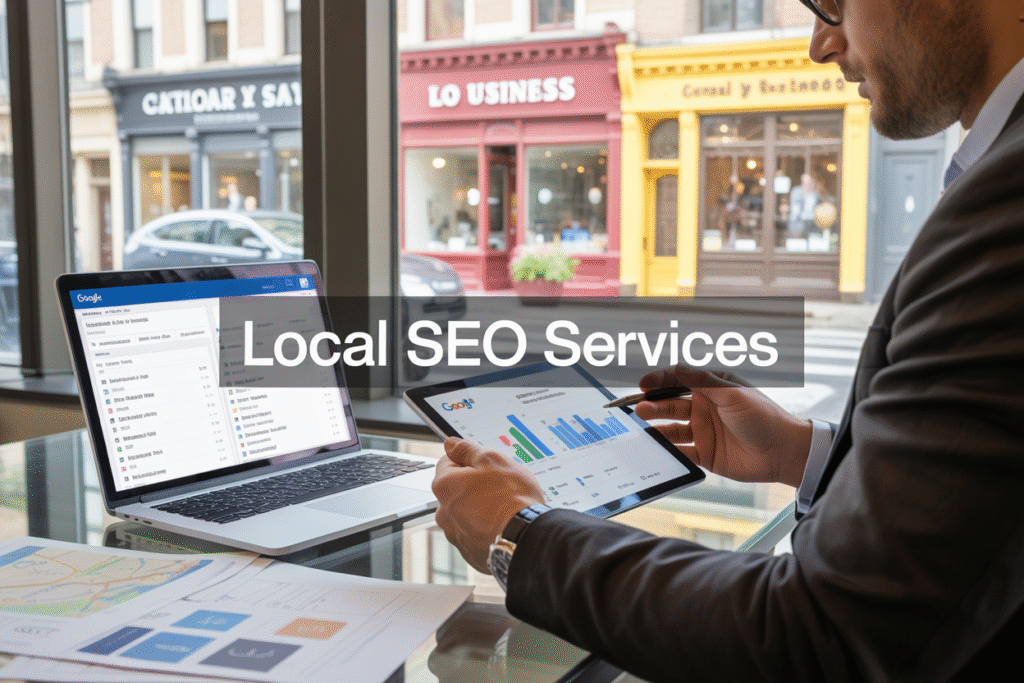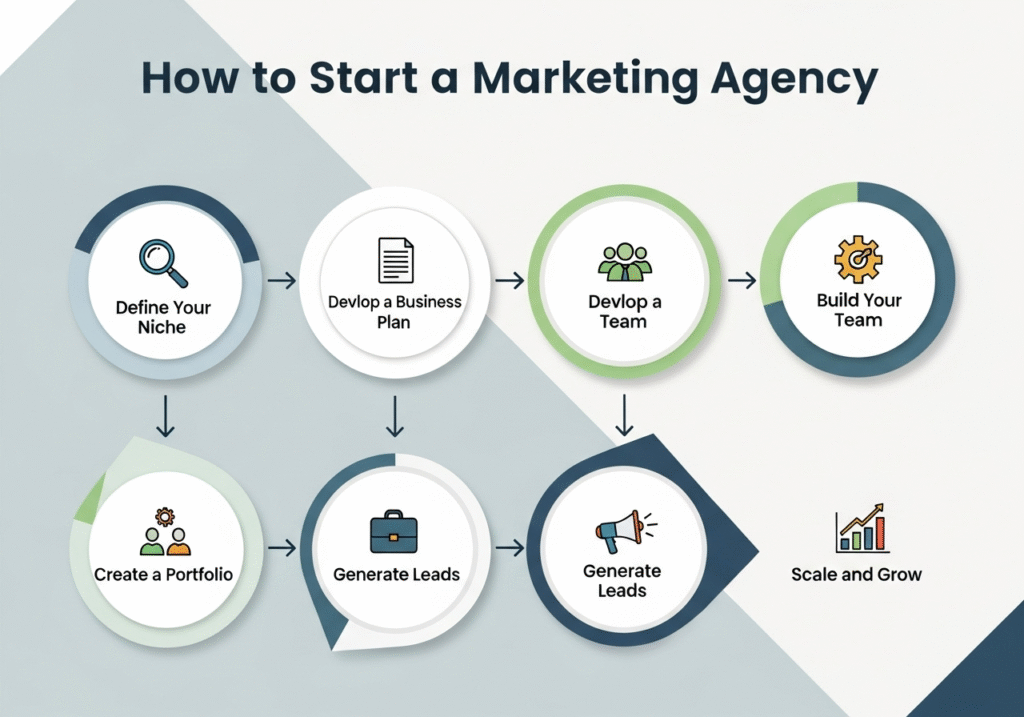Local business owners and marketing managers know that showing up in local search results can make or break their growth goals. Local SEO services lead marketing strategies that help your business connect with nearby customers actively searching for your products and services.
When done right, these digital marketing strategies drive qualified leads directly to your door while building long-term visibility in your community. This guide is designed for small business owners, local entrepreneurs, and marketing professionals who want to harness the power of local search to grow their customer base
You’ll discover proven local SEO strategies that deliver real results, from optimizing your Google Business Profile to building authority in local search rankings. We’ll also cover advanced tactics that give you a competitive edge and show you how to measure the actual ROI from your local marketing investments.
What Is Local SEO Services For Business Growth?

Key Components of Local Search Optimization
Local SEO services encompass several critical elements that work together to boost your business visibility in local search results. Google Business Profile optimization serves as the foundation, requiring complete and accurate business information including name, address, phone number, hours, and service areas.
This profile acts as your digital storefront, displaying reviews, photos, and essential business details directly in search results. Citation building forms another crucial component, where your business information appears consistently across online directories, review sites, and local platforms.
Search engines use these citations to verify your business legitimacy and location accuracy. Local keyword targeting focuses on terms that include geographic modifiers like “near me,” city names, or neighborhood references that potential customers actually search for.
Online reputation management through review generation and response strategies builds trust and credibility. Customer reviews significantly influence local search rankings and purchase decisions.
Creating location-specific content that addresses local interests, events, and community needs helps establish topical authority within your market area.
How Local SEO Differs From Traditional SEO Strategies
Local SEO services lead marketing strategies through a hyper-focused geographic approach that contrasts sharply with broader SEO tactics. While traditional SEO targets national or global audiences, local search optimization concentrates on capturing customers within specific geographic boundaries.
The keyword strategy differs dramatically. Traditional SEO might target “restaurant delivery,” while local SEO focuses on “pizza delivery downtown Seattle” or “family restaurants near Pike Place Market.” This geographic specificity creates less competition and higher conversion rates since searchers have clear location intent.
Local SEO heavily emphasizes proximity signals and location-based ranking factors. Google’s algorithm considers the searcher’s physical location, business location, and the distance between them when determining rankings. Traditional SEO relies more on domain authority, content depth, and backlink profiles.
| Traditional SEO | Local SEO |
|---|---|
| National/global reach | Geographic boundaries |
| High-volume keywords | Location-specific terms |
| Domain authority focus | Proximity and relevance |
| General content topics | Community-centered content |
| Link quantity emphasis | Local citation quality |
Impact on Local Customer Discovery And Foot Traffic
Local search optimization directly influences how customers discover your business during critical decision-making moments. Research shows that 76% of people who search for local businesses visit within 24 hours, and 28% of those searches result in purchases. This immediate connection between search and action makes local SEO services essential for driving foot traffic.
Mobile searches drive much of this behavior, with “near me” searches growing exponentially. When someone searches for “coffee shop near me” or “auto repair downtown,” they’re actively seeking immediate solutions. Businesses appearing prominently in these results capture customers at peak buying intent.
Google My Business insights reveal how local visibility translates to real-world actions. Customers use these profiles to call businesses, request directions, visit websites, and view photos. Each interaction represents a potential customer who discovered your business through local search efforts.
Voice search amplifies this trend, as people ask virtual assistants for local recommendations. Optimized businesses capture these conversational queries and guide customers to their locations through clear, accessible information.
Connection Between Local Visibility And Revenue Growth
Strong local search presence creates a direct pipeline between digital marketing for local businesses and measurable revenue increases. Businesses ranking in the top three local search results receive significantly more clicks, calls, and visits compared to those appearing further down.
Local lead generation through SEO typically produces higher conversion rates than traditional advertising methods. These leads come from people actively searching for your services within your service area, indicating strong purchase intent.
The cost per acquisition often proves lower than paid advertising while delivering more qualified prospects. Revenue impact compounds over time as local SEO builds momentum. Positive reviews generate more reviews, improved rankings drive more visibility, and increased visibility attracts more customers.
This creates a growth cycle where initial SEO marketing strategies investments continue paying dividends. Small businesses especially benefit from this approach since local SEO levels the playing field against larger competitors.
A well-optimized local business can outrank national chains in local results by focusing on community relevance and customer relationships rather than just marketing budgets.
Essential Local SEO Strategies That Drive Results

Google My Business Optimization Techniques
Your Google Business Profile serves as the digital storefront for your local business, making optimization absolutely critical for local SEO services lead marketing strategies.
Start by claiming and verifying your listing, then fill out every available field with accurate information. Upload high-quality photos that showcase your business, products, and team – listings with photos receive 42% more requests for directions and 35% more clicks to websites.
Regular posting keeps your profile active and engaging. Share updates about new services, special offers, events, and behind-the-scenes content. These posts appear directly in search results and help establish your business as active and current.
Enable messaging features to allow customers to contact you directly through your profile. Quick response times to messages signal to Google that your business is actively managed, which can boost your local search ranking.
Select the most specific categories possible for your business. While primary categories are most important, adding relevant secondary categories helps Google understand what you offer and when to show your business in search results.
Local Keyword Research and Implementation
Effective local business marketing starts with understanding how potential customers search for your services. Local keyword research differs from traditional SEO because it focuses on geo-specific terms and local intent.
Tools like Google Keyword Planner, SEMrush, and Ahrefs can help identify valuable local search terms. Target primary keywords that include your location and service, such as “plumber in [city name]” or “[city] dental services.”
Long-tail keywords often convert better because they capture specific local intent. Someone searching for “emergency AC repair downtown Denver” has clear local intent and immediate need.
Implement these keywords naturally throughout your website content, especially in:
- Page titles and meta descriptions
- Header tags (H1, H2, H3)
- Service pages and location pages
- Image alt text and file names
- URL structures
Create location-specific landing pages if you serve multiple areas. Each page should target keywords specific to that location while providing unique, valuable content about your services in that area.
Building Consistent NAP Citations Across Directories
NAP consistency (Name, Address, Phone number) across all online directories and platforms forms the foundation of local SEO for small business success. Search engines use this information to verify your business legitimacy and determine local search rankings.
Start by auditing your current citations to identify inconsistencies. Even small variations like “Street” versus “St.” or different phone number formats can confuse search engines and dilute your local authority.
Focus on high-authority directories first:
| Primary Directories | Industry-Specific | Local Directories |
|---|---|---|
| Google Business Profile | Yelp | Chamber of Commerce |
| Facebook Business | TripAdvisor | Local newspapers |
| Apple Maps | Angie’s List | City websites |
| Bing Places | Houzz | Regional blogs |
Submit your business information to relevant directories, prioritizing quality over quantity. A handful of authoritative, accurate citations outperform dozens of low-quality or inconsistent ones.
Monitor your citations regularly using tools like Moz Local or BrightLocal to catch any changes or new listings that might appear with incorrect information.
Managing and Leveraging Customer Reviews
Customer reviews significantly impact local lead generation and search rankings. Google considers review signals as one of the top ranking factors for local search results. Businesses with consistently positive reviews typically outrank competitors with fewer or lower-rated reviews.
Develop a systematic approach to requesting reviews from satisfied customers. Send follow-up emails after completed services, include review requests in receipts, or create simple QR codes that link directly to your review profiles.
Respond to all reviews promptly and professionally. Thank customers for positive reviews and address concerns in negative reviews constructively. Your responses show potential customers how you handle feedback and demonstrate your commitment to customer service.
Use review content as inspiration for FAQ sections, service improvements, and marketing messages. Positive reviews often highlight specific benefits customers value most, providing authentic language for your digital marketing for local businesses efforts.
Create a review management workflow:
- Monitor reviews daily across all platforms
- Respond within 24-48 hours
- Thank reviewers by name when possible
- Address specific points mentioned in reviews
- Learn from feedback to improve services
Creating Location-Specific Content That Converts
Location-specific content helps establish local relevance and captures search traffic for geo-targeted keywords. This content goes beyond basic service pages to provide genuine value for local customers while supporting your SEO marketing strategies.
Create comprehensive local resource guides that showcase your expertise while highlighting community connections. A roofing company might publish “Winter Weather Preparation Guide for [City Name] Homeowners” or “Historic District Building Regulations in [Area].”
Develop content around local events, news, and seasonal topics. Participate in community discussions online and create content that references local landmarks, businesses, and cultural elements. This approach builds local authority and helps search engines understand your geographic relevance.
Case studies featuring local customers (with permission) provide social proof while targeting location-based keywords. Document successful projects, customer challenges, and outcomes specific to your service area.
Blog about local partnerships, community involvement, and sponsorships. Search engines recognize businesses that actively participate in their local communities, and this content often earns natural backlinks from local organizations and media outlets.
Remember that location-specific content should always provide genuine value to readers while naturally incorporating relevant local keywords and geographic references.
Advanced Local Marketing Tactics For Competitive Advantage

Hyperlocal Content Marketing Strategies
Creating content that speaks directly to your neighborhood audience can completely transform how local businesses connect with customers. Hyperlocal content marketing goes beyond generic city-wide messaging to focus on specific neighborhoods, streets, or even individual blocks where your business operates.
Start by identifying the unique stories within your immediate area. Cover local events, highlight neighborhood landmarks, and discuss community issues that matter to your neighbors.
When you write about the new coffee shop opening three blocks away or the weekend farmers market happening in your area, you’re creating content that search engines recognize as highly relevant to local users.
The key is to think like a neighbor, not just a business owner. Share insights about local traffic patterns, weather impacts on your services, or seasonal changes affecting your community.
This approach naturally incorporates location-specific keywords that help your local seo services efforts while providing genuine value to readers. Consider creating location-specific landing pages for different neighborhoods you serve.
Each page should address the unique needs and characteristics of that area. A plumbing company might discuss older home pipe issues in historic districts while highlighting modern home services in newer developments.
User-generated content works exceptionally well for hyperlocal strategies. Encourage customers to share photos of your products or services in recognizable local settings. These authentic images and testimonials create powerful social proof while strengthening your connection to specific geographic areas.
Local Link Building and Community Partnerships
Building meaningful relationships with other local businesses and organizations creates a network of mutual support that search engines value highly. The goal isn’t just collecting links – it’s becoming an integral part of your community’s digital ecosystem.
Start by identifying natural partnership opportunities. Restaurants can collaborate with local farms, fitness studios can partner with nutritionists, and retail stores can work with complementary service providers.
These relationships often lead to organic link exchanges, joint events, and cross-promotional opportunities that benefit everyone involved. Community involvement generates some of the most valuable local links. Sponsor local sports teams, participate in charity drives, or host community workshops.
When local newspapers, event websites, and community blogs mention your involvement, they typically include links to your website. These editorial links carry significant weight with search engines because they represent genuine community recognition.
Local lead generation improves dramatically when you become a trusted resource for other businesses. Create a local business directory on your website, write about other companies’ success stories, or offer expert commentary on industry trends affecting your area.
Other businesses often reciprocate by mentioning your expertise and linking to your content. Don’t overlook local educational institutions, libraries, and government websites.
Many of these organizations maintain resource lists for residents and businesses. Getting included in these directories requires demonstrating genuine value to the community, but the links often carry exceptional authority.
Chamber of Commerce membership and participation in local business associations provide structured networking opportunities that naturally lead to link building.
Active members who contribute to discussions, attend events, and support other businesses typically receive more mentions and links from fellow members.
Voice Search Optimization for Mobile Users
Voice search behavior differs significantly from traditional typing, and local seo services must adapt to these changing patterns. People using voice search tend to ask complete questions rather than entering fragmented keywords, especially when looking for local information.
Focus on conversational phrases and natural language patterns. Instead of optimizing for “pizza delivery downtown,” think about how someone actually speaks: “Where can I get pizza delivered near me right now?” or “What pizza places are open late tonight?” These longer, more natural phrases should guide your content creation and seo marketing strategies.
Create FAQ sections that directly answer common voice search queries about your business and industry. Structure these answers to provide immediate value while naturally incorporating location-specific information.
When someone asks their phone “What time does the hardware store close?” your optimized content can provide that answer along with your address and phone number.
Google Business Profile optimization becomes crucial for voice search success. Ensure your business hours, location information, and contact details are accurate and complete.
Voice assistants frequently pull this information when responding to local business queries, making your profile a critical component of your voice search strategy.
Mobile page speed affects voice search rankings significantly since most voice searches happen on mobile devices. Users expect immediate answers, so slow-loading pages hurt your chances of being selected as the voice search result.
Optimize images, streamline code, and use reliable hosting to ensure fast load times across all devices. Consider the context of voice searches – people often ask these questions while driving, walking, or multitasking.
Your content should provide clear, concise answers that make sense when heard rather than read. This means avoiding complex sentences, technical jargon, or information that requires visual elements to understand completely.
Measuring Success and ROI from Local SEO Investments

Key Performance Indicators For Local Search Campaigns
Successful local SEO services require precise measurement through carefully selected KPIs that align with business objectives. Local search impressions show how often your business appears in search results, while click-through rates reveal the effectiveness of your title tags and meta descriptions in attracting potential customers.
Google Business Profile insights provide valuable data including profile views, website clicks, direction requests, and phone calls. These metrics directly correlate with customer engagement and indicate whether your local business marketing efforts are reaching the right audience.
Organic traffic from local searches represents visitors actively seeking your products or services in your area. Track this metric alongside keyword rankings for location-based terms like “near me” searches and city-specific queries. Conversion rates from local traffic paint a clearer picture of campaign effectiveness than raw visitor numbers.
| KPI Category | Primary Metrics | Secondary Metrics |
|---|---|---|
| Visibility | Local search impressions | Average position |
| Engagement | CTR, Profile views | Photos viewed |
| Action | Direction requests | Phone calls |
| Revenue | Local conversion rate | Customer lifetime value |
Tracking Local Rankings and Visibility Improvements
Local search ranking monitoring requires specialized tools that track position changes across different geographic locations. Your business might rank differently in various neighborhoods within your service area, making location-specific tracking essential for comprehensive performance analysis.
Map pack rankings deserve special attention since these prominent positions generate significantly more clicks than traditional organic results. Track your presence in the three-pack for high-value keywords and monitor fluctuations that could indicate algorithm updates or increased competition.
Review signals impact local visibility substantially. Monitor new review velocity, average rating changes, and response rates to customer feedback. These factors influence both search rankings and customer trust, creating a compound effect on overall local performance.
Brand mention tracking across local directories, review sites, and social platforms provides insight into your business’s digital footprint expansion. Consistent NAP (Name, Address, Phone) information across these platforms strengthens local SEO authority and improves ranking stability.
Converting Local Traffic into Paying Customers
Local lead generation success depends on creating seamless pathways from search results to customer acquisition. Landing pages optimized for local searches should prominently display location information, contact details, and clear calls-to-action that encourage immediate engagement.
Phone call tracking reveals which marketing channels drive the highest-quality leads. Local customers often prefer calling businesses directly, making phone conversions a critical metric for service-based companies. Implement call tracking numbers to attribute conversions accurately to specific campaigns.
Online-to-offline attribution presents unique challenges but offers valuable insights into customer behavior patterns. Track promotional codes, specific landing page visits, and appointment bookings that originate from local search traffic. This data helps optimize seo marketing strategies for maximum conversion potential.
Customer journey mapping for local searches typically involves multiple touchpoints before conversion. Someone might discover your business through Google Maps, visit your website, read reviews, then visit your physical location. Understanding these pathways helps optimize each touchpoint for better conversion rates.
Long-term Benefits and Sustained Business Growth
Digital marketing for local businesses compounds over time, creating sustainable competitive advantages that become increasingly difficult for competitors to replicate. Established local SEO authority builds momentum that protects market share while reducing customer acquisition costs.
Customer lifetime value increases when businesses maintain strong local search presence. Repeat customers and referrals generated through local visibility create predictable revenue streams that stabilize business operations and support expansion planning.
Local market dominance creates powerful moats around your business territory. Once your google business profile optimization and local content strategies establish authority, maintaining top positions requires less effort than initial ranking achievements.
This efficiency allows resource allocation toward growth initiatives rather than defensive tactics. Geographic expansion becomes more manageable with proven local SEO frameworks.
Successful strategies can be replicated in new markets, accelerating growth while minimizing risks associated with entering unfamiliar territories. This scalability makes local SEO investments increasingly valuable as businesses expand their footprint.
Common Local SEO Mistakes That Hurt Business Growth

Neglecting Google My Business maintenance
Your Google My Business profile serves as the digital storefront for your local seo services, yet many businesses treat it like a “set it and forget it” tool. This approach severely limits your local search ranking potential and wastes valuable lead marketing strategies opportunities.
Regular GMB maintenance requires consistent effort across multiple areas. Your business hours need updates during holidays, seasonal changes, or temporary closures.
Photos should showcase recent work, updated interiors, or new service offerings. Customer reviews demand timely responses – both positive feedback acknowledgments and professional replies to negative experiences.
Many local businesses miss out on GMB’s posting features, which function like mini social media updates. These posts highlight special offers, announce new services, or share company news directly in search results. Active posting signals Google that your business stays engaged with customers.
The Q&A section often goes unmonitored, allowing incorrect information to spread or customer questions to remain unanswered. Smart business owners seed this section with frequently asked questions about their seo marketing strategies and services, controlling the narrative while providing valuable information to potential customers.
Outdated or missing business attributes hurt your visibility in specific searches. If you’re an HVAC contractor who doesn’t list “emergency repairs” as an attribute, you’ll miss leads from people searching for urgent services. Regular audits ensure all relevant services and features are properly tagged.
Inconsistent Business Information Across Platforms
NAP (Name, Address, Phone) consistency across the web directly impacts how search engines understand and rank your local business marketing efforts. When your business information varies between your website, Google My Business, Facebook, Yelp, and industry directories, search engines receive conflicting signals that can suppress your rankings.
Common inconsistencies include using different business name variations (like “ABC Marketing LLC” versus “ABC Marketing”), formatting addresses differently (using “Street” versus “St.”), or maintaining old phone numbers on some platforms while updating others.
Even minor variations like including or excluding suite numbers can create problems. The issue compounds when considering industry-specific directories. A restaurant might be listed on OpenTable, DoorDash, and local dining guides – each potentially displaying different information.
Professional service businesses face similar challenges with lawyer directories, medical listings, or contractor platforms. Digital marketing for local businesses becomes significantly more effective when information stays consistent.
Search engines develop confidence in your business data, leading to improved local search visibility and higher rankings for location-based queries. Regular citation audits help identify discrepancies across platforms.
Create a master document with your official business information, then systematically update each platform where you’re listed. This includes checking employee bio pages, press releases, and any third-party websites that might reference your business details.
Ignoring mobile optimization requirements
Mobile searches drive the majority of local business discovery, making mobile optimization critical for effective local lead generation. Yet many businesses still operate websites that frustrate mobile users, directly impacting their ability to convert local search traffic into customers.
Page loading speed becomes crucial on mobile networks. Local searchers often browse while commuting, shopping, or dealing with urgent needs – they won’t wait for slow-loading pages.
Images that aren’t properly compressed, excessive plugins, or heavy design elements can create delays that send potential customers to competitors. Touch navigation presents unique challenges that desktop-focused designs often ignore.
Buttons placed too close together, small text requiring zoom, or navigation menus that don’t work properly with touch gestures create friction in the user experience. Local customers researching seo for small business options expect websites that function smoothly on their phones.
Click-to-call functionality should be seamlessly integrated throughout mobile sites. When someone finds your business through local search, they want immediate contact options.
Phone numbers that aren’t clickable, contact forms that don’t resize properly, or directions that don’t integrate with mapping apps create unnecessary barriers. Local business marketing success depends on mobile users being able to quickly find essential information: hours, location, services, and contact details.
This information should be prominently displayed and easily accessible without extensive scrolling or menu navigation. Many businesses bury their contact information or store hours in secondary pages, frustrating mobile users who need quick answers.
Voice search optimization also connects to mobile usage patterns. People use voice assistants on mobile devices to find local businesses, asking questions like “Where’s the nearest marketing agency?” or “What time does the hardware store close?” Your website content should address these natural language queries to capture voice search traffic.

Local SEO isn’t just another marketing buzzword – it’s your ticket to connecting with customers right in your neighborhood. From optimizing your Google My Business profile to building local citations and managing online reviews, these strategies work together to put your business on the map when people search for what you offer.
The advanced tactics like hyperlocal content creation and community partnerships can give you that extra edge over competitors who are still figuring out the basics. The best part about local SEO is that you can actually see the results.
Track your local rankings, monitor foot traffic, and measure those phone calls coming in from your optimized listings. Just remember to avoid those costly mistakes like inconsistent business information or ignoring negative reviews.
Start with the fundamentals, stay consistent with your efforts, and watch your local visibility grow. Your future customers are already searching for businesses like yours – make sure they can find you first.



